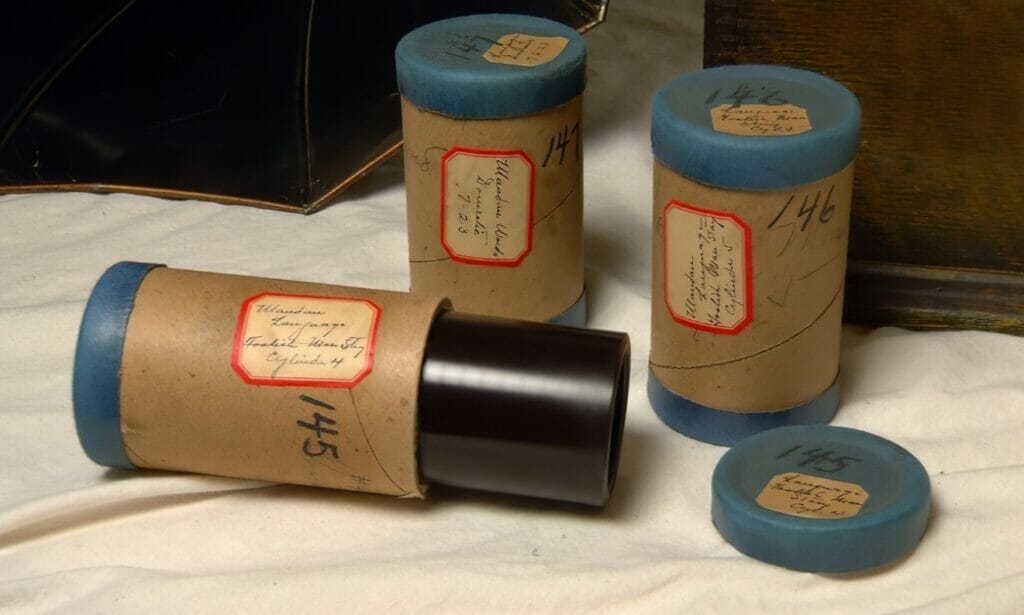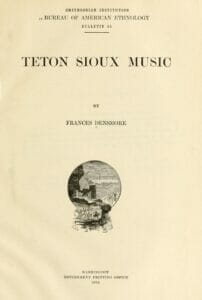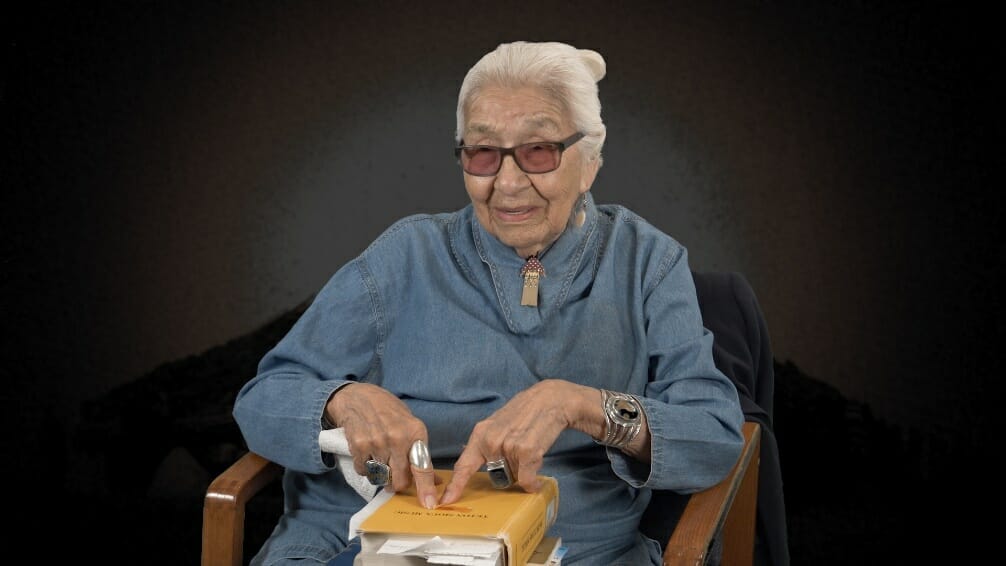
Frances Densmore playing back a recording to Mountain Chief, 1916 (Library of Congress). https://www.loc.gov/item/2004667752
The American Folklife Center, Library of Congress, houses the works of the ethnomusicologist Frances Theresa Densmore, including a collection of more than 2,500 American Indian songs she recorded between 1907 and 1941. Approximately 260 of Densmore’s cataloged recordings were made at the Standing Rock Reservation in the Dakotas between 1911 and 1914. These wax cylinder recordings made over a century ago are a voice from the past that still speaks to the Lakota people today.
Lakota culture embraces strength and family, power and gratefulness, and acknowledges the past while looking toward the future. Many Lakota value and honor the land, treating it as a living member of their own families. Their songs are about all these things. The music of the Lakota people is proof of a culture that survived despite all that it suffered.
Densmore’s work, along with other available ethnographic materials, represent an opportunity for reclaiming heritage and culture, and for teaching difficult or unknown histories. Teaching with primary sources reveals very complex influences—gender, gender roles, familial relationships, language barriers, language translation, changes in technology for good or bad, politics, and, above all, reclamation and hope for a voice to be heard—that shape and guide those very materials. These influences are revealed to great extent in the groundbreaking work that ensued with the original Lakota and Dakota songs Densmore recorded and with this current project repatriating the music back to the Lakota.

The late Kevin Locke, Lakota author, educator, musician, and NEA National Heritage Fellow, May 1, 2022. Photo by Dennis J. Neumann for the Densmore Repatriation Project.
In 1993 the late renowned Lakota flute player and hoop dancer Kevin Locke introduced Densmore’s work to the twice-nominated Grammy producer and co-owner of Makoché Studios, David Swenson of Bismarck, North Dakota. Locke’s interest was in learning the old songs she had recorded, but he was having trouble understanding and transcribing the singer’s words. Locke impressed upon Swenson the cultural importance of preserving these old songs. In her book, Teton Sioux Music, Densmore writes, “The songs comprised in the first group, almost without exception, were recorded by men 65 to 80 years of age. This group contains 147 songs believed to be from 50 to 150 years old. The oldest songs, which are considered the best songs, were composed in dreams” (Densmore 1918, 22).
Locke described her work as a preservation of the “old songs of the Lakota people,” and described the recordings as “hard to understand” and “very old sounding.” He expressed his desire to get a clearer, cleaner copy and asked if Swenson could help. Swenson attempted to improve the sound using available technology of the time. Locke was kind in his assessment of the effort, but Swenson felt there was much more that could, and should, be done.
Swenson contacted Judith Gray, Head of Reference and Native American subject matter expert at the American Folklife Center, about purchasing a set of higher quality copies. He was granted permission by then Standing Rock Tribal Council Chairman Jesse Taken Alive to purchase a copy from the Library of Congress and received the digital tapes on November 7, 1996. His plan was to make an indexed CD set and make it available to the library of Sitting Bull College at Standing Rock. His initial work proved frustrating; the sound of the tapes was still very bad. Something just did not seem right.

Densmore wax cylinders from the State Historical Society of North Dakota collection.
Photo by David Swenson.
In September 1996 while reviewing the Densmore recordings, the actual transfer speed of the tapes became suspect. Swenson investigated further and eventually came to the reel marked AFS 10,582B. He had not recognized it before, but that reel contained several of the few recordings Densmore had made of women singers. It was difficult to recognize the singers as women because the recordings did not sound like women at all. When he increased the tape speed by approximately 11 percent, the tapes sounded correct. After checking other masters in the collection, it became apparent the entire collection had been transferred to the current version of digital masters at an incorrect speed.

Hear Densmore speed correction examples: https://vimeo.com/816342039
Swenson was able to verify his findings by measuring the distance between “spikes” or cracks in the cylinders and matching them to the correct revolutions per minute, along with matching the pitch-pipe Densmore blew as a reference tone at the beginnings of certain recordings. In his excitement and naiveté, he assumed this discovery would be welcomed, but instead, it met resistance. Swenson sent his detailed analysis to Thomas Vennum, at that time Senior Ethnomusicologist with the Smithsonian Center for Folklife and Cultural Heritage, and on November 22, 1996, received his response. Vennum wrote that the while he could not vouch for the accuracy of the transfers, “one must be careful that today’s Native singers aren’t imposing their own aesthetic judgement when they say a song from 1910 is “too low, too slow.” Almost 20 years later his findings were acknowledged in the 2015 book Travels with Frances Densmore (Jensen and Patterson 2015). Judith Gray at the American Folklife Center wrote about the efforts to correct the speed variations, stating that Michael Donaldson, Library of Congress Recording Lab engineer, “concurs with David Swenson’s initial assessment that at least on the Sioux recordings, the lab’s recording engineers in the 1940s interpreted Densmore’s reference pitch as an A rather than the higher C she had, in fact, used” (Gray 2015, 381).
The Recording Lab has since corrected the playback speed. Efforts to replace incorrect collections at museums and institutions, including tribal colleges, are ongoing. In 2022 Judith Gray graciously provided Swenson with a speed-corrected copy of the Densmore Teton Sioux recordings. Correcting these recordings was a small return made to a living society. It is cleaning the glass to see the past clearly, and to learn from it.

Frances Densmore transcribing from her wax cylinders in 1915
(LC-H261- 6136).
Photo by Harris & Ewing, 1915.
Frances Densmore
Frances Theresa Densmore was born in Red Wing, Minnesota, in 1867, just two years after the American Civil war ended, and five years after the Dakota War of 1862 in Minnesota, which resulted in the deaths of 358 settlers and 106 soldiers. After the Dakota surrendered, President Abraham Lincoln reviewed the convictions and approved death sentences for 39 of the Dakota men. Eventually, 38 were hung in the largest one-day mass execution in the United States. This is the nation that Frances Densmore grew up in, a society damaged by civil war and racial struggle.
In her childhood home near the Upper Mississippi, she would lie in bed at night and hear the singing and drumming of the Sioux* people camped across the river. Densmore wrote about this in Frances Densmore and American Indian Music, A Memorial Volume:
Opposite the town, on an island, was a camp of Sioux Indians and at night, when they were dancing, we could hear the sound of the drum and see the nicker of their campfire. In the twilight I listened to these sounds, when I ought to have been going to sleep. Instead of frightening me with stories of war dances and scalps, my wise mother said, “Those Indians are interesting people with customs that are different from ours, but they will not hurt you. There is no reason to be afraid of them.” So, I fell asleep with my mind full of fancies about the “interesting people” across the Mississippi. (Hoffman 1968, 1)
Years later, she would often begin her lectures with the line, “I heard an Indian drum.”
Densmore began working for the Smithsonian Institution’s Bureau of American Ethnology in 1907. This was a time when the field was dominated by men, and she struggled at times. In her 50-plus year career of studying and preserving American Indian music, she wrote over 20 books and collected over 2,500 recordings of some 30 different tribal nations. Most of the recordings she made are now held by the Library of Congress.
 Although some of Densmore’s scientific methodology now seems archaic, and some of her ways of dealing with Indigenous peoples questionable, it must be remembered that she helped to preserve Native culture when U.S. federal government policy actively pursued forcing Native Americans to adopt Western customs and forget their own. The tribes were confined to ever-shrinking reservations. Their religious practices were forbidden. The use of Native language was banned in “Indian schools.” Because of this, her work represents a somewhat unique occurrence of Western technology benefiting Indigenous peoples. Through one of her most substantial works, Teton Sioux Music, much of Lakota culture was preserved.
Although some of Densmore’s scientific methodology now seems archaic, and some of her ways of dealing with Indigenous peoples questionable, it must be remembered that she helped to preserve Native culture when U.S. federal government policy actively pursued forcing Native Americans to adopt Western customs and forget their own. The tribes were confined to ever-shrinking reservations. Their religious practices were forbidden. The use of Native language was banned in “Indian schools.” Because of this, her work represents a somewhat unique occurrence of Western technology benefiting Indigenous peoples. Through one of her most substantial works, Teton Sioux Music, much of Lakota culture was preserved.
Densmore faced three main obstacles while working at Standing Rock. One was finding a suitable interpreter, and she found a more than capable one in Robert Higheagle, whose contributions to her work cannot be overstated.
Another issue was finding locations appropriate for her recordings along with finding qualified and willing participants. Robert Higheagle’s contributions became crucial. Higheagle lived in two worlds. As a boy he was sent to boarding school and finished his education at the Hampton Institute in Virginia. Higheagle understood Densmore’s methodology and needs. He was also a Lakota who understood the culture and guided Densmore to interact appropriately with tribal members. Higheagle knew how to find the best singers and informants and would ride on horseback for miles to connect with them and secure their participation.
Densmore also faced the awkward cultural issue of being a single white woman recording the testimony and singing of tribal men. The origin of the solution is unclear, but at a council meeting in July of 1911 Tȟokála Lúta (Red Fox) declared his intention to adopt Densmore as his daughter. Red Fox had the right to do this as he had lost his own daughter and it was the accepted custom to “adopt” a new one. This made Densmore a member of the tribe, a position she exploited to her own advantage.
Densmore later wrote, “My adoption into the tribe will be of the greatest help in this study as it is widely understood that I am entitled to anything which a member of the tribe is entitled to…old men would not hold back anything from me” (Jensen and Patterson 2015, 81-7).
Frances Densmore died on June 5, 1957, at the age of 90 at her home in Red Wing, Minnesota.

Densmore’s office and recording location, McLaughlin, South Dakota, 1913 (LOC).
The Densmore Repatriation Project
In 1927 Frances Densmore wrote, “Research work is only valuable when its results are transmitted to others” (Jenson 2011). This was the guiding principle of the Densmore (Lakota/Dakota Song) Repatriation Project.
David Swenson discussed his long-time efforts on the Densmore Teton Sioux Music recordings with his colleague and mentor, Troyd Geist, the state folklorist with the North Dakota Council on the Arts. The original recordings are preserved and housed at the American Folklife Center, Library of Congress, but they are not easily accessible. Additionally, the cataloging system makes it very difficult to identify specific songs for further study. To rectify these issues, Swenson, Geist, and several members of the Standing Rock Nation collaborated in designing a project and writing a Bush Foundation grant proposal to support the ease of repatriating and reintroducing Lakota and Dakota songs to the Standing Rock Reservation. Another goal was to provide additional cultural context to the songs from today’s knowledge keepers and elders. The proposal was awarded generous support on August 12, 2021, with additional funds coming from Humanities North Dakota to Dakota Legacy, Makoché’ Studio’s nonprofit arm.

Densmore’s Columbia Graphophone wax cylinder recorder. All the recordings from Standing Rock were made using this machine. Courtesy Minnesota Historical Society.
While Densmore used a Columbia Graphophone wax cylinder recorder, the advanced technology of her time, to preserve traditional stories and songs, Swenson used today’s advanced digital and video technology to help share and reintroduce the materials to the very people who created them. The overarching goal of the project was to reintroduce the songs and stories to the Lakota community and to make them more accessible for a new generation of Native singers and educators. The importance of this cannot be understated for two primary reasons.
One, at the time of Densmore’s original recordings, it was illegal for Native Americans to speak their language or practice their traditional ways. The Lakota and Dakota men and women who sang for her were risking fines, imprisonment, or worse. It took bravery for them to do what they did. They did so, hoping there would be a time when the songs could be sung freely and openly within their social and spiritual structures.
Two, the songs are not just songs. They encapsulate the entire Lakota culture and way of life. These songs are connected to the history, spirituality, worldview, morals, guidance, health, education, environment, language, and much more of the Lakota people. When those are forbidden, much is lost, and the culture becomes fragmented over time with elements continuing in what the Lakota refer to as their “underground.” It wasn’t until 1978 that Native Americans were legally allowed to practice their own religions. Repatriation of these songs is essential to that religious freedom and to making the culture whole again.
The sound recordings had been catalogued in numbered groups with no easy correlating reference to Densmore’s companion book, Teton Sioux Music. This made the study of individual songs beyond challenging. To overcome this obstacle, each song was separated and matched to the entries found in Teton Sioux Music. Swenson also did additional sound restoration.
Once the audio was restored and the songs matched to the book, Swenson and Geist worked with talented, influential, contemporary traditional Lakota powwow singers to re-learn and re-record these songs. Doing this helped make the songs more easily accessible and understandable. It also placed them directly into the existing, active, and extensive social structure of the powwow system, creating an immediate and widespread impact by putting the knowledge and materials directly into the repertoire, hearts, and minds of not just the powwow singers, but also the entire communities attending the powwows. In this way, the power and process of reassembling missing parts of Lakota culture is squarely in the hands of the people themselves—a community of individuals, not institutions. The intent was to make it possible for people to reclaim their culture regardless of institutional, financial, educational, or political access or hurdles.

Courtney Yellowfat. Photo by Dennis J. Neumann for the Densmore Repatriation Project.
Courtney Yellowfat, a leader of a Grammy-nominated traditional Lakota drum group, was a project co-producer and primary cultural advisor. He enlisted the help of other young Lakota singers: Jerren Elk, Spencer Little Owl, Kendall Little Owl, Khannie Tobacco, Kelcie Two Shields, Cody Wasinzi, and John Eagle Shield Jr., to re-record over 70 of these songs at Makoché Studios in Bismarck. John Eagle Shield Jr. sang the same songs his great-great-grandfather sang for Densmore over a century ago.

Densmore records participants in the Sun Dance. Photo by Frances Densmore.
Courtesy State Historical Society of North Dakota.
The songs and their place in the culture of the Lakota and Dakota is complex and sometimes fragmented, and it was obvious that we needed the guidance of elders and tribal historians. A group of these knowledge keepers were interviewed about the songs, their meaning, and their importance to the culture. This group included two National Endowment for the Arts National Heritage Fellowship recipients, the late Kevin Locke and Mary Louise Defender Wilson, along with Standing Rock Elders Preservation Council members Virgil Taken Alive, Cedric Goodhouse, Evelyn “Sissy” Goodhouse, Thomas Red Bird, Terry Yellowfat, John Thomas Eagle Shield Sr., and Tim Mentz Sr. Their insights provided the foundation for 35 videos detailing the culture, the meanings of songs, and further information about the project. The work of this repatriation project, built upon first-source ethnographic fieldwork materials from over 100 years ago tied to first-source ethnographic materials from today, resulted in a dynamic effort of a Nation, the Lakota and Dakota, to further reclaim their heritage.

Mary Louise Defender Wilson being interviewed, June 2, 2022.
Photo by Dennis J. Neumann for the Densmore Repatriation Project.
The unveiling of the completed project took place on September 10, 2022, appropriately at United Tribes Technical College’s Annual International Powwow in Bismarck, North Dakota. Toward the end of the unveiling, Courtney Yellowfat’s six-year-old granddaughter sang Song 1, “Song of the White Buffalo Maiden.” The White Buffalo Maiden is at the core of Lakota spirituality and is placed as this first song recorded in Densmore’s book. Courtney taught his granddaughter this song and has been teaching it to other children in her class in the Standing Rock School system.


Educational Materials Produced from the Project
All the materials produced by the Densmore Repatriation Project are intended for free distribution and use. A comprehensive website to review these videos, recordings and other materials can be found at lakotasongs.com.
These first-source ethnographic materials fill important educational, cultural, spiritual, and linguistic desires and goals, first and foremost, for members of the Standing Rock Nation. While doing so, they reveal complexities and history that are often difficult and unknown to broader society. Efforts like this create space for understanding, healing, and conversation. This work will take place informally and organically within the informal cultural structures, such as the traditional powwow singer network or in ceremonies conducted by knowledge keepers, of Lakota and Dakota society.
These materials also have a place within formalized structures and institutions such as schools. In April of 2021, North Dakota passed SB2304, legislation that requires all public and non-public schools to teach Native American history as a requirement for graduation. Full implementation of this bill goes into effect in 2025 making access to primary sources and ethnographic materials housed in institutions such as the Library of Congress, state folklore archives, and other repositories critically important.
Outline of Available Educational Materials
- Information about Frances Densmore and her work at Standing Rock
- An updated e-book version of Teton Sioux Music
- Restored and cataloged copies of Densmore’s original wax cylinder recordings
- Over 70 songs from the collection re-recorded in 2022
- Thirty videos explaining the meanings and significance of the songs
- Eight writings for further study and lesson plans for classroom use
- 1,000 USB sticks containing all the above materials
- Website presence for the materials [lakotasongs.com]
As a rich primary source, The Densmore Repatriation Project opened the door for the development of a unit of study to support the goals of SB2304. The resulting integrated unit of study takes root in the enduring/overarching understanding that relations between differing cultures can elicit both conflict and cooperation, and that music and/or other forms of cultural expression can be a vehicle for developing knowledge, understanding, and cultural appreciation. By cutting across subject-matter lines and emphasizing unifying concepts, students are encouraged to ask questions, make connections, and deepen their understanding and appreciation of Native American history and culture.
These 100-year-old and current primary source materials provide the foundation for the Densmore Repatriation Unit Plan for grades 9-12. Through these detailed plans that use Visual Thinking Strategies and other educational approaches, North Dakota Native American Essential Understanding, Social Studies, Music, and Visual Arts Standards are all achieved. And, importantly, through an examination of the Densmore Repatriation Project, important discussions can be held about unknown history and the varying forces that shape that history and its telling. To access this plan, go to lakotasongs.com and click on the “Study Guide” tab.
In conclusion, it is best to reflect on the words of Itȟúkasaŋ Lúta (Red Weasel), one of Densmore’s informants. When Red Weasel gave his information concerning the Sun Dance, he was approximately 80 years old, yet he traveled 43 miles by wagon to participate. Before singing his first song (Song 14, “Song Sung after Raising the Sacred Pole”), Red Weasel bowed his head in prayer. Densmore started the wax cylinder recorder and captured his voice.
Wakȟáŋ Tȟáŋka, hear me. This day I am to tell your word. But without sin I shall speak. The tribe shall Live. Behold me for I am humble. From above watch me. You are always the truth, listen to me, my friends and relatives, sitting here, and I shall be at peace. May our voices be heard at the future goal you have prepared for us. (Densmore 1918, 94-95)

To view the 35 videos online, use this link:
https://vimeopro.com/makoche/the-densmore-repatriation-project
* “Sioux” refers to a confederacy of several tribal nations that speak a dialect of the same language family; those dialects being Lakota, Dakota, and Nakota.
Find an excerpt from the Densmore Repatriation Project Education Unit with Lesson one reprinted with permission from the authors in the Classroom Connections in the left sidebar. The full unit, along with additional Study Guides and resources may be found at https://www.lakotasongs.com/book.
David Swenson, Executive Producer of the Densmore Repatriation Project is a twice-nominated Grammy producer and co-owner of Makoché studios in Bismarck, North Dakota. His passion for restoring the Densmore recordings resulted in this project. Swenson continues to work with other Densmore collections and hopes to replicate this project with additional tribes, including working with the Mandan, Hidatsa, and Arikara Music collection now housed at the State Historical Society of North Dakota.
Rebecca Engelman, Educator and Curriculum Developer, is a former Visual Arts Instructor and Arts in Education Director for the North Dakota Council on the Arts. An experienced program director with over 30 years of experience, she is highly regarded for her work as an educator and advocate for the arts. In 1999 she received the North Dakota Governor’s Award for Arts in Education and in 2010 a Bush Fellowship from the Bush Foundation to support her development as a leader in the arts.
Troyd Geist, State Folklorist and Advisor to the Densmore Repatriation Project, is charged with helping promote the health and vitality of folk and traditional culture and arts in North Dakota through his position with the North Dakota Council on the Arts. He has worked extensively with Native American communities throughout the state including exhibits, recordings, apprenticeships, traditional culture and health, and special projects. ORCID 0009-0009-6966-7616

Courtney Yellowfat and David Swenson. Photo by Dennis J. Neumann for the Densmore Repatriation Project.
Works Cited
Densmore, Frances. 1918. Song 14, Song Sung after Raising the Sacred Pole. In Teton Sioux Music and Culture. Washington, DC: Government Printing Office, 94-5.
Gray, Judith. 2015. An Archival Dilemma: The Densmore Cylinder Recording Speeds. In Travels with Frances Densmore, Her Life, Work, and Legacy in Native American Studies. Lincoln: University of Nebraska Press.
Hoffmann, Charles. 1968. Frances Densmore and American Indian Music: A Memorial Volume. New York: Museum of the American Indian/Heye Foundation.
Jensen, Joan M. 2011. Frances Densmore Gets the Depression Blues. Minnesota History. 62.6:216-27.
Jensen, Joan M. and Michelle Wick Patterson, eds. 2015. Travels with Frances Densmore, Her Life, Work, and Legacy in Native American Studies. Lincoln: University of Nebraska Press.
URLs
North Dakota Council on the Arts https://www.arts.nd.gov
North Dakota Council on the Humanities https://www.humanitiesnd.org
Dakota Legacy http://www.makoche.com
Densmore Repatriation Project comprehensive website lakotasongs.com
